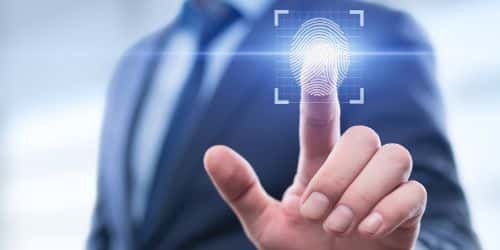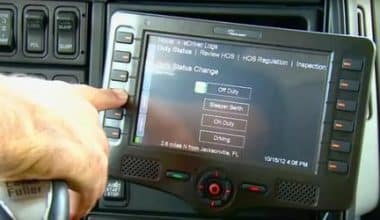Today’s biometric authentication methods are classified into several types, but they all serve the same purpose. Furthermore, the core of how they work is the same: they measure and analyze the unique characteristics inherent in a specific person to confirm that person’s identity. In this article, we will look at what biometric authentication is and how it works. We will also look at the advantages and disadvantages, and examine iPhone biometric authentication apps examples.
As a result, physical documents are gradually becoming obsolete and being replaced by biometric identification. It can also be said that modern technology has advanced significantly, allowing people to unlock mobile devices with their fingerprints or transfer money using voice commands.
What Is Biometric Authentication?
Biometrics is a technical term that refers to the physical or behavioral characteristics of humans. Biometric authentication is a data security concept. Biometric authentication solutions generate a data-driven model of the individual.
Security systems can authenticate access to applications and other network resources using that model and biometric information. Because it combines a strong authentication challenge with a low-friction user experience, biometric authentication is quickly becoming a popular component of multifactor authentication strategies.
How Does Biometric Authentication Work?
The biometric authentication process compares two sets of data: the first is pre-programmed by the device owner, and the second belongs to a device visitor. If the two data are nearly identical, the device recognizes that “visitor” and “owner” are the same person and grants access.
The key point to remember is that the match between the two data sets must be nearly identical but not exact. This is because matching two biometric data sets is nearly impossible. For example, you could have a slightly sweaty finger or a very small scar that alters the print pattern.
Designing the process so that it does not require an exact match reduces the likelihood of a false negative (the device does not recognize your fingerprint), but it also increases the likelihood that a fake fingerprint will be accepted as genuine.
Types of Biometric Authentication
Let’s take a look at the most popular types of biometric identification right now:
#1. Fingerprint Scanners
Fingerprint scanners, the most common type of biometric authentication method, scan the swirls and ridges that are unique to each individual’s fingertips. Current technological advancements have resulted in scanners that scan for vascular patterns in addition to fingerprint ridges. This has helped to reduce the number of false positives that occur with consumer-grade biometric options found on smartphones. Fingerprint scanners continue to be the most widely available and popular.
#2. Facial Recognition
Facial recognition technology, like fingerprint scanners, scans a person’s face based on approved and saved parameters and measurements. These parameters are referred to as faceprints. Only when many of them are met is access granted. Despite inconsistencies in matching faces to parameters from different angles or distinguishing between similar or related people, facial recognition is used in a variety of smart devices.
#3. Voice Recognition
This version of scanning technology focuses on vocal characteristics to differentiate between people. A voice is recorded into a database, and several data points are saved as voiceprint parameters. Rather than simply listening to a voice, vocal recognition technologies concentrate on mouth and throat shape formation and sound quality. This reduces the possibility of misreading a voice imitation attempt.
#4. Eye Scanners
Retina and iris scanners are examples of eye scanners. A retina scanner shines a bright light into the eye to highlight blood vessel patterns that can be read by the scanner. These readings are compared to the data in the database. Iris scanners look for distinct patterns in the colored ring around the pupil. Both types of scanners are ideal for hands-free verification.
Examples of Biometric Authentication
Biometric authentication is used in nearly every industry, from finance and health care to retail and travel. Because of the increasing prevalence of account takeover fraud, organizations require secure authentication and identification procedures more than ever.
Some examples of how these businesses are using biometric authentication to improve the security and efficiency of existing processes are provided below.
#1. Banking and Financial Industry
Security and authentication are critical in a variety of industries, particularly in the financial sector. Financial institutions and banking organizations are incorporating biometric authentication into their daily operations to perform customer identification and process user information more quickly. According to a Cision PR Newswire study, biometric authentication is used by nearly half of the most popular mobile banking applications.
#2. Healthcare Industry
This is one of the examples of biometric authentication.
Biometric services are used in healthcare facilities to verify patients’ identities and keep a record so that whenever a person comes to the hospital, their medical records can be easily and quickly accessed by their doctor, preventing mix-ups.
The stored data can be used to ensure that patients receive the care they require, whether that means faster identification in emergencies, better medical diagnosis, or avoiding medical errors.
#3. Academic Sector
Biometric authentication can also be used in school management systems where keeping attendance records for students and teachers is common practice. It is useful because it records students’ arrival and departure times from school, as well as teachers’ work hours. The automated recording of student identities improves educational activities significantly.
#4. Travel and Hospitality Sector
Exclusive airlines and airports are allowing customers to check in for flights using facial recognition. Similarly, hotels and hospitality establishments are beginning to allow self-check-in via biometric authentication.
Examples of Businesses Using Biometric Authentication Services Around the World
#1. Disney’s Biometric Fingerprint Scanners
Since 2013, Disney has used fingerprint biometrics as part of its access system. All customers over the age of three must scan their entry tickets and place their fingers on a scanner to verify identification at Disneyland and Walt Disney World’s entry gates.
#2. Barclays biometric technology
Barclays is one of the examples of biometric authentication. It was also one of the first to offer one-touch fingerprint banking access, and it has since added voice-enabled biometrics to its biometric strategy. This system lets the contact center of a financial institution tell who is calling based on the first few words they say.
#3. American Airlines facial recognition biometrics
American Airlines is one of the biometric authentication examples and the largest airline company in the United States that has used biometric technology successfully. They have developed a biometric facial recognition program that is meant to speed up the boarding process for their customers.
Biometric Authentication Advantages and Disadvantages
Biometric authentication techniques are ultimately about security. Because the password (or PIN code, on occasion) is their main competitor, a comparison of the two will reveal both their strengths and weaknesses. Let’s look at the advantages and disadvantages of biometric authentication below:
Advantages:
#1. Simple to use
A fingerprint or iris scan is far more convenient to use than a password, especially if it is long. Most modern smartphones recognize a fingerprint in less than a second (if at all) and allow the user to access the phone. Ultrasound scanners will become more common shortly because manufacturers can place them directly behind the screen without taking up any extra space on a phone. Voice recognition, on the other hand, is more problematic, and background noises can easily disrupt the process and render it inoperable.
#2. The malicious hacker must be close to you
The most significant advantage of biometric authentication is that a malicious hacker must be physically close to you to collect the information needed to bypass the login. This reduces the number of potential suspects if your biometric lock is compromised. Because of his proximity, he is more likely to be caught red-handed than regular malicious hackers working from another continent.
#3. Biometrics are difficult to counterfeit or steal
With today’s technology, biometrics such as facial recognition, fingerprint or retina scanning, and others are nearly impossible to replicate. There is a one in 64 billion chance that your fingerprint will match someone else’s exactly.
Disadvantages:
#1. Remote revocation of the fingerprint/iris/voice is not possible
One significant disadvantage of biometric security is that it cannot be changed remotely. If you lose access to an email, you can always perform a remote recovery to regain control. During the process, you will be able to change your password or enable two-factor authentication to increase the security of your account. Biometrics, on the other hand, does not work in this manner. To change the device’s initial, secure data set, you must be physically close to it.
#2. Many phones and scanners can be fooled by “master fingerprints”
When you first register a fingerprint, the device will request several presses from various angles. These samples will then be compared to subsequent unlock attempts as the original data set. However, because smartphone sensors are small, they frequently rely on partial fingerprint matches. Researchers discovered that a set of five “master fingerprints” can take advantage of these partial matches and unlock approximately 65% of devices. In practice, the number is likely to be lower, but even a 10% to 15% open rate is significant and can expose millions of devices.
#3. Biometrics are permanent
If your password is compromised, you can always change it, but you can’t change your iris, retina, or fingerprint. Once someone has a working copy of these, there isn’t much you can do to protect yourself other than use passwords or another finger. The US Office of Personnel Management leaked 5.6 million employee fingerprints in one of the largest hacks in history. For those involved, a piece of their identity will always be jeopardized. In CPO Magazine, we looked at even more dangers of using biometric data, particularly in law enforcement.
#4. Vulnerabilities in biometric authentication software or apps
Security researchers discovered flaws in Android devices a few years ago that allowed them to remotely extract a user’s fingerprint, use backdoors in the software to hijack mobile payments, or even install malware. Furthermore, they were able to do so remotely, without physically accessing the device.
What Is Biometric Authentication on the iPhone?
Touch ID (also known as biometric authentication) has been included in iOS devices since the iPhone 5S. Some users, however, were and continue to be hesitant to use it. Face ID, a more recent feature, may appear even more intimidating to those unfamiliar with Apple products. A comprehensive guide to configuring these time-saving options, as well as some of their useful applications, is provided below.
To begin, if you’ve recently purchased a new iPhone or iPad, the Startup Guide should walk you through the Touch ID and Face ID setup processes when you first activate the device (biometric authentication). So, for this guide, we’ll assume you’ve already set up your device while skipping those steps.
Face ID Biometric Authentication on iPhone
You can enable Face ID biometric authentication if you have an iPhone 11 or later, or an iPad Pro 11in or 12.9in.
- Launch the Settings application.
- Select “Face ID & Passcode” (you may need to enter your password here).
- To proceed, tap the “Set Up Face ID” button.
- Hold your device in front of your face vertically, then tap “Get Started.”
- Slowly rotate your head in a circle while keeping your entire head because of the camera. (Tap accessibility options for more information.)
- Tap Continue and repeat the previous step, rotating your head in a circle until the ID is complete.
If you haven’t already set a password, you may be prompted to do so now as a backup method of unlocking the device. Additional Face ID-related settings can be found in the “Face ID & Passcode” section.
Touch ID Biometric Authentication on iPhone
You can use Touch ID authentication (biometric identification) on your device if you have an iPhone 5s or later, or an iPad 5th generation or later.
- Before you begin, use a screen wipe to clean the home button and ensure that your fingers are clean and not wet.
- Launch the Settings application.
- Select “Touch ID and Passcode.” To proceed, you may be prompted to enter your device’s password.
- Select “Add a Fingerprint.”
- Gently press your finger on the home button, but not hard enough to activate it.
- Lift your finger in response to on-screen prompts or when you feel your device vibrate.
- Repeat this process for each scan, slightly rotating and repositioning your finger.
- The screen will then instruct you to “Adjust your grip,” so make sure you’re holding your device with one hand as you normally would while using it.
- Finish the scan with your thumb. This allows your device to recognize your thumb more easily while holding your device regularly for convenience.
You can use your fingerprint as verification for purchases while signing in to your Apple account on your device, rather than having to type in your password every time! Simply enable “iTunes and App Store” in the Settings app’s “Touch ID & Passcode” section. When you buy something on your device, you’ll be asked to scan your finger. Touch ID can also be used for Apple Pay on iPhone 6 and up.
Biometric Authentication Apps
Biometric authentication apps now come in a variety of architectures, solutions, and device options. Businesses seeking strong user authentication should consider deploying biometric authentication for end-to-end security. When shortlisting a solution, they should first understand their business needs and existing infrastructures. When used correctly, this technology can provide several advantages to a company. Here are some biometric authentication apps to consider.
#1. Centrify
For password-free authentication, Centrify’s Adaptive Multi-factor Authentication makes use of the WebAuthn API. It is simple to integrate into device hardware, whether there are built-in scanners or external authenticators.
#2. Fischer Identity
To prevent password vulnerabilities, Fischer Identity provides identity authentication via five authentication factors, including biometrics. Biometrics provided an easy way for multifactor authentication protocols to work with diverse characteristics. It can also be modified to fit different situations. Fischer’s architecture eliminates the need for customization. This is ideal for businesses that want to set up authentication policies quickly and easily.
#3. HID Global
HID Global is an extended access technology company that has developed Lumidigm, a multispectral imaging technology for biometric security. They’ve also incorporated liveness detection, spoof prevention, and proof of life technologies. The service also offers biometric tools tamper-proofing and data encryption.
#4. Identity Automation
Identity Automation provides the RapidIdentity MFA package, which protects businesses across all access points. It addresses active directories, offline desktops, on-premise applications, and the cloud. At the time of enrollment, Identity Automation also includes fingerprint biometrics and a user-selected PIN. RapidIdentity MFA also works with embedded and USB-based fingerprint sensors.
#5. Imageware Systems
ImageWare Biometric Engine provides enterprises with a scalable, multi-modal biometric identity management solution. This vendor’s services are available as part of a web-based biometric enrollment. It is also accessible via biometric identification technology. In its verification process, Imageware employs one or more biometric factors and performs 1:1 biometric searches.
What Is an Example of Biometric Authentication?
Here are some common biometric authentication security examples: Speech recognition, Fingerprint recognition, and Face recognition.
Why Is Biometric Authentication Needed?
Maximum security:
One of the most important reasons why biometric authentication has become necessary is security concerns. Payment fraud activities such as card skimming, chip switching, shoulder surfing, and so on can be eliminated with biometric authentication.
How Do I Get Biometric Authentication?
Subjects are identified using retinal scans by analyzing the pattern of blood vessels at the back of their eyes. Iris recognition uses an image of the iris to identify people. Fingerprint scanning uses fingerprints to identify people.
Is Fingerprint Biometric Authentication?
Fingerprint biometrics is used to authenticate (match a person’s biometric template) as well as identify (determine the identification of a person). Biometrics is a person’s unique physical characteristics that can be used to validate and verify their identity.
What Is the Best Biometric Authentication?
Iris recognition is widely regarded as the most accurate biometric identification modality.
Where Is Biometric Authentication Used?
It is used in systems such as national identity cards for identification and health insurance programs that may use fingerprint identification. Airport safety. Biometrics, such as iris recognition, is used in this field on occasion.
Conclusion
Biometric recognition improves safety by linking a person to their personal data record. It’s possible to add biometrics such as fingerprints, facial features, and even voiceprints. When combined with additional safeguards, biometric authentication increases an organization’s safety. People are less likely to create many identities as a result.
Thanks for reading, and I hope you found the examples of biometric authentication on iPhone useful.
What Is Biometric Authentication FAQs
Which devices are used for biometrics?
Different Types of Biometric Devices:
- Optical sensors.
- Capacitive scanners.
- Ultrasonic sensors.
- Thermal line sensors.
- Biometric authentication devices.
- Biometric identification devices.
- Physiological Identifiers.
- Biometric security devices and their use.
How is biometric data stored?
Biometric data can be saved on the device of the end user. This is most common on smartphones that use fingerprint sensors with Touch ID, such as Apple’s ‘Secure Enclave.’ On-device storage can be used to store biometric data via a chip that is separate from the device’s network.
What is the difference between biometrics and fingerprint?
A biometric fingerprint is not the same as a fingerprint.
A fingerprint biometric is a representation of multiple points on the fingerprint as well as their relative positions.






